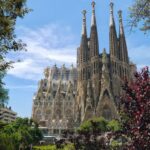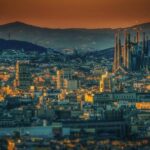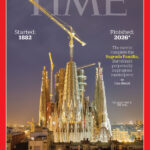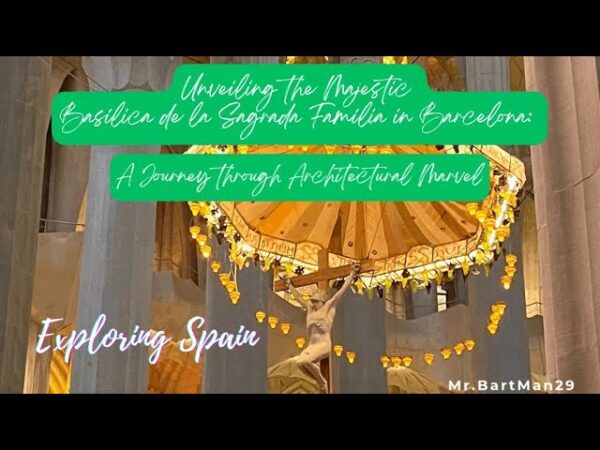
- The History Behind the Sagrada Familia: A Journey Through Time
- The Architectural Innovations of Antoni Gaudí in the Sagrada Familia
- Exploring the Symbolism of the Sagrada Familia's Design Elements
- The Construction Timeline of the Sagrada Familia: From Beginnings to Present
- Why the Sagrada Familia is a UNESCO World Heritage Site
- Visitor's Guide: How to Experience the Sagrada Familia in Barcelona
The Sagrada Familia, a masterpiece designed by the renowned architect Antoni Gaudí, stands as one of the most iconic symbols of Barcelona. This magnificent basilica, with its intricate facades and towering spires, draws millions of visitors each year, eager to experience its unique blend of Gothic and Art Nouveau styles.
In this article, we embark on a journey through the remarkable features and innovative techniques that define this architectural gem. Join us as we explore The Sagrada Familia: Unveiling the Architectural Marvel, a testament to Gaudí's genius and his unwavering dedication to creating a sanctuary that transcends time and tradition.
The History Behind the Sagrada Familia: A Journey Through Time
The history of the Sagrada Familia is as intricate as its design, beginning in 1882 when construction first commenced under architect Francisco de Paula del Villar. However, the visionary Gaudí took over the project in 1883, transforming it into a lifelong passion that would occupy him until his untimely death in 1926. Gaudí's innovative approach emphasized organic forms and natural light, which would redefine church architecture.
Throughout its construction, the Sagrada Familia has encountered various challenges, including funding issues and the impact of the Spanish Civil War. Despite these obstacles, the basilica has seen significant milestones, including:
- 1910: Completion of the crypt
- 1935: The first tower was finished
- 2010: Gaudí was posthumously named a saint
As we journey through the timeline of this architectural marvel, it becomes clear that the Sagrada Familia is not just a building but a symbol of resilience and creativity. Each phase of its construction reflects the evolving vision of Gaudí, marrying art, architecture, and spirituality in a way that continues to inspire awe and admiration.
Today, the Sagrada Familia stands not only as a testament to Gaudí's genius but also as a living project, with completion projected for 2026, marking the centenary of Gaudí's death. This ongoing journey highlights the collaborative spirit of countless artisans and architects dedicated to bringing Gaudí's dream to fruition, ensuring that it remains a beacon of architectural innovation for generations to come.
The Architectural Innovations of Antoni Gaudí in the Sagrada Familia
Antoni Gaudí's architectural innovations in the Sagrada Familia are profound and groundbreaking. One of his key approaches was the use of hyperbolic paraboloids, a unique geometric form that allows the structure to withstand significant loads. This innovative technique not only enhances the stability of the basilica but also creates stunning visual effects, particularly in the vaults and arches, which mimic natural forms and patterns found in nature.
Moreover, Gaudí employed a technique known as catenary arches, which are curved shapes that distribute weight evenly. This design choice is evident in the soaring columns of the basilica, which rise like tree trunks and branch out to support the roof, reminiscent of a forest canopy. This integration of nature into architecture exemplifies his vision of harmony between the built environment and the natural world.
The innovative use of light also plays a critical role in Gaudí's design. He meticulously planned the placement of stained glass windows to allow sunlight to filter through, creating a vibrant play of colors within the interior. This not only enhances the spiritual atmosphere of the Sagrada Familia but also showcases Gaudí's belief in the transformative power of light as a divine element.
In addition to these techniques, Gaudí's attention to detail is remarkable. He incorporated various materials, such as stone, brick, and ceramic tiles, to achieve a textured and dynamic facade. Each element serves a purpose and contributes to the overall aesthetic, highlighting his commitment to both artistry and functionality. The Sagrada Familia stands as a testament to Gaudí's visionary approach, making it a true architectural marvel.
Exploring the Symbolism of the Sagrada Familia's Design Elements
The Sagrada Familia's design is rich with symbolism, reflecting Gaudí's deep spiritual beliefs and connection to nature. The basilica's towering spires represent the twelve apostles, with the tallest spire dedicated to Jesus Christ, symbolizing his central role in Christianity. This verticality draws the eye upwards, creating an ethereal connection between the earth and the divine.
Moreover, the façades of the Sagrada Familia, meticulously crafted to narrate the life of Christ, serve as a visual storytelling medium. The Nativity Façade, for instance, celebrates the birth of Jesus with intricate sculptures that embody themes of joy and wonder. In contrast, the Passion Façade portrays the suffering and crucifixion, emphasizing sacrifice and redemption. This duality in design highlights the spectrum of the Christian experience.
The interior of the Sagrada Familia is equally symbolic, featuring columns that resemble tree trunks, which evoke the feeling of being in a forest. This design choice not only reinforces Gaudí's admiration for nature but also signifies growth, life, and the interconnectedness of all creation. The interplay of light and color through the stained glass enhances this experience, creating a spiritual ambiance that invites reflection and contemplation.
| Design Element | Symbolism |
|---|---|
| Spire Height | Represents the twelve apostles; tallest for Jesus |
| Nativity Façade | Celebrates the birth of Christ; themes of joy |
| Passion Façade | Depicts suffering and redemption |
| Tree-like Columns | Symbolize nature and interconnectedness |
The Construction Timeline of the Sagrada Familia: From Beginnings to Present
The construction of the Sagrada Familia began in 1882, initially led by architect Francisco de Paula del Villar. However, it was in 1883 that Antoni Gaudí took over the project, imbuing it with his unique architectural vision. Gaudí's approach not only transformed the basilica into a personal lifelong project but also set the stage for innovative construction techniques that would evolve throughout the years.
Over the decades, the timeline of the Sagrada Familia has been marked by significant milestones and challenges. The onset of the Spanish Civil War in the 1930s led to disruptions and a halt in construction, causing delays that would stretch the project for decades. Notable achievements include:
- 1910: The completion of the crypt, foundational to Gaudí's design.
- 1935: The finishing of the first tower, symbolizing progress.
- 2021: The completion of the Passion Façade, a significant addition to Gaudí's original vision.
As we move closer to the anticipated completion date in 2026, the Sagrada Familia continues to evolve, reflecting both Gaudí's original artistry and modern advancements in construction. The ongoing efforts symbolize a collective dedication to realizing a masterpiece that transcends generations and stands as a beacon of architectural innovation and creativity.
The collaborative spirit behind the construction is evident, with numerous architects and artisans dedicating their skills to the project. Each phase of the Sagrada Familia's timeline showcases not only Gaudí's genius but also the resilience of those committed to bringing this architectural marvel to life, ensuring its place in history as a profound expression of faith and artistry.
Why the Sagrada Familia is a UNESCO World Heritage Site
The Sagrada Familia was inscribed as a UNESCO World Heritage Site in 2005 due to its exceptional architectural significance and unique design. Gaudí's innovative use of forms, colors, and materials reflects a fusion of Gothic and Art Nouveau styles, embodying a distinct artistic vision that has had a lasting influence on modern architecture. The basilica is not only a remarkable feat of engineering, but also a testament to the creative spirit of a pivotal era in European history.
One of the key reasons for its UNESCO designation is the incorporation of sustainable architecture principles throughout its construction. Gaudí's designs mimic natural forms, utilizing techniques that promote harmony between the structure and its environment. This approach not only enhances the visual appeal but also contributes to the structural integrity of the building, making the Sagrada Familia a pioneering example of how architecture can coexist with nature.
The site also holds immense cultural and spiritual significance, attracting millions of visitors who come to explore its majestic beauty and profound symbolism. Each aspect of the Sagrada Familia narrates a story, from the intricately crafted façades to the ethereal interiors, making it a pilgrimage site for both the faithful and art enthusiasts alike. This cultural richness underscores its status as a UNESCO World Heritage Site, as it preserves a vital part of Spain's artistic and religious heritage.
Furthermore, the Sagrada Familia's ongoing construction showcases a remarkable dedication to craftsmanship and collaboration. Since its inception, countless artisans and architects have contributed to this living monument, ensuring that Gaudí's vision continues to evolve while remaining true to its original intent. This commitment to preserving and enhancing the basilica's artistic legacy is a key factor in its recognition as a UNESCO World Heritage Site, highlighting the importance of cultural continuity in an ever-changing world.
Visitor's Guide: How to Experience the Sagrada Familia in Barcelona
Visiting the Sagrada Familia is an unforgettable experience, and planning ahead can enhance your journey through this architectural wonder. Begin by purchasing your tickets online to avoid long queues. Consider choosing a time during early morning or late afternoon for a more tranquil visit, when the light casts stunning colors through the stained glass windows, creating a magical atmosphere.
Once inside, be sure to take advantage of the audio guide option, which offers in-depth insights into Gaudí's life and the basilica's intricate details. As you explore, pay attention to the unique features that reflect Gaudí's innovative design, such as the tree-like columns and the various façades. To make the most of your visit, plan to spend at least 1.5 to 2 hours exploring the interior and exterior.
For those wanting a deeper understanding of the Sagrada Familia, consider joining a guided tour. This allows for a more personalized experience, as expert guides share fascinating stories and hidden details about the basilica's construction and symbolism. Additionally, you can take part in special events or attend a mass service to witness the spiritual significance of this magnificent structure.
Lastly, don't miss the opportunity to explore the surrounding area. Nearby, you can find beautiful parks and restaurants where you can relax and reflect on your visit. Here’s a quick overview of key tips to maximize your experience:
- Buy tickets online: Save time and avoid queues.
- Visit early or late: Enjoy a quieter atmosphere and stunning light.
- Use an audio guide: Gain deeper insights into Gaudí's work.
- Consider a guided tour: Discover hidden gems and stories.
 Discover the Complete Sagrada Familia: Barcelona's Architectural Masterpiece
Discover the Complete Sagrada Familia: Barcelona's Architectural Masterpiece The Sagrada Familia: 🏰🇪🇸 Gaudí's Masterpiece in Barcelona
The Sagrada Familia: 🏰🇪🇸 Gaudí's Masterpiece in Barcelona The Sagrada Familia Barcelona: A Masterpiece Completed
The Sagrada Familia Barcelona: A Masterpiece CompletedIf you want to know other articles similar to The Sagrada Familia: Unveiling the Architectural Marvel you can visit the category WHERE YOU CAN GO.
Deja una respuesta










Read more!